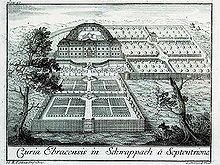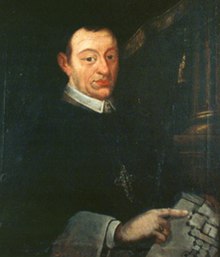Wilhelm I. Solner
Wilhelm I. Sölner (also Wilhelm Selner ; born December 30, 1671 in Gerolzhofen , † April 20, 1741 in Ebrach ) was abbot of the Cistercian monastery in Ebrach from 1714 to 1741 .
Life
Early years
Wilhelm Sölner was born on December 30, 1671 in Gerolzhofen, Lower Franconia . His family were well-respected citizens of the city. At the age of five, Wilhelm was sent to the Ebrach Cistercian School in Würzburg in order to receive a solid education there. The so-called Golden Books , which Wilhelm received as a reward for extraordinary academic achievements, testify to the hard work of the future abbot . Sölner passed his Matura in Würzburg .
After finishing school, Sölner attended the Jesuit-run university in Ingolstadt . He completed a degree in theology. On November 21, 1691 he made his vows in Ebrach and soon afterwards left for the befriended Waldsassen monastery . There he was trained in rhetoric and wrote several disputations . Sölner went to Prague and studied history, political science and law at the university there. He received his doctorate and then taught church law.
His academic career was interrupted when he was called back to his monastery. In Ebrach Sölner became the office director and thus held the highest secular office of the abbey. During his tenure, Wilhelm Sölner wrote a short pamphlet against the Diocese of Würzburg , which questioned Ebrach's imperial immediacy . He also fought for the exemption of the Burgwindheim monastery parish .
As abbot
After the resignation of his predecessor Paulus II Baumann , Sölner was appointed as his successor at the express request of the emeritus . On April 30, the unanimous choice was made: Wilhelm Sölner was Abbot William I. On June 2, 1715 was the Würzburg Prince Bishop Johann Philipp von Greiffenklau benediziert . As abbot, Sölner supported the poor in the monastery catchment area and let everyone dine in the monastery. A total of 65 new religious were admitted to the monastery by 1741.

At the same time, the abbot promoted science in the monastery and expanded the abbey library. Abbot Sölner also began to develop a distinctive building activity and promoted the early baroque in his dominion. The new parish church in Oberschwappach was built in 1721, and the official palace in Sulzheim was built from 1722 to 1728 . New churches were also built in Weyer, Herlheim and Mönchstockheim. The church in Alitzheim was completed in 1733. The abbot had the official courts in Elgersheim and Waldschwind renewed, the so-called castle in Oberschwappach from 1733 to 1738 and the castle in Burgwindheim rebuilt.
In Ebrach, the rococo park around the abbey was built under Wilhelm I. Sölner . He had the roof turret of the Gothic church renewed and rebuilt in the Baroque style. Sölner tried to counteract the recurring epidemics in the secluded surroundings of the monastery by building a hospital. The early baroque, so-called monastery suburb around the convent building was also created under his government.
Towards the end of his life he was commissioned by the General Chapter to compile the rights and privileges that had been accumulated in the long history of the Ebrach monastery and thus to counter the claims of the Duchy of Würzburg , which wanted to achieve supremacy over the abbey. That is why the Brevis Notitia (short description) about the monastery was created in 1738 . The work underlined Ebrach's imperial immediacy.
For the Würzburg Prince-Bishop Friedrich Karl von Schönborn-Buchheim , the document was a "disgrace". He commissioned his archivist Seitz to publish a reply and had the work publicly prohibited. A new edition appeared in 1739, supported by the Vatican . Sölner was planning a new font that should reveal his intentions. However, the work remained unfinished because Wilhelm Sölner died on April 24, 1741 at the age of seventy. On April 29, the abbot was buried in the monastery church.
coat of arms
Due to the brisk construction activity under Abbot Wilhelm Sölner, his personal coat of arms can also be found everywhere in the former domain of the monastery.
Description : “Above right a sun with rays, below left a flower. The timing is unclear. The coat of arms can be found on a lintel in Elgersheim, the former buildings of the monastery suburb in Ebrach and on the south portal of the main monastery building. In addition, the coat of arms was attached to the portal of the Jakobskirche in Herlheim . "
plant
- Wilhelm Sölner: Brevis notitia monasterii BVM Ebracensis Sacri Ordinis Cisterciensis in Franconia: Ex probatis Authoribus, tum impressis, tum scriptis, ex originalibus Diplomatibus, ex antiquis Documentis et Scripturis desumpta, et in hunc ordinem redacta. A quodam ejusdem Loci et Ordinis Religioso . Rome 1738.
literature
- Adelhard Kaspar: Chronicle of the Ebrach Abbey . Münsterschwarzach 1971.
- Rainer Wailersbacher: "Dominus providebit - the Lord will do providence!": Divine show and worldview of the Ebrach abbot Wilhelm Sölner (1714/41), the builder of Oberschwappach Castle . Knetzgau 1992.
- Josef Wirth: The Ebrach Abbey. To commemorate eight hundred years. 1127-1927 . Gerolzhofen 1928.
Web links
Individual evidence
- ↑ Wailers Bacher, Rainer: "Dominus providebit" . P. 10.
- ↑ Wailers Bacher, Rainer: "Dominus providebit" . P. 11.
- ↑ Wailers Bacher, Rainer: "Dominus providebit" . P. 19.
- ↑ Wirth, Josef: The Ebrach Abbey . P.56.
- ↑ Kaspar, Adelhard: Chronicle of the Ebrach Abbey . P. 172.
| predecessor | Office | successor |
|---|---|---|
| Paul II Baumann |
Abbot of Ebrach 1714–1741 |
Jerome II hero |
| personal data | |
|---|---|
| SURNAME | Sölner, Wilhelm I. |
| ALTERNATIVE NAMES | Söllner, Wilhelm; Selner, Wilhelm; Sellner Guillelmus (Latin) |
| BRIEF DESCRIPTION | German Cistercian abbot |
| DATE OF BIRTH | December 30, 1671 |
| PLACE OF BIRTH | Gerolzhofen |
| DATE OF DEATH | April 20, 1741 |
| Place of death | Ebrach |

